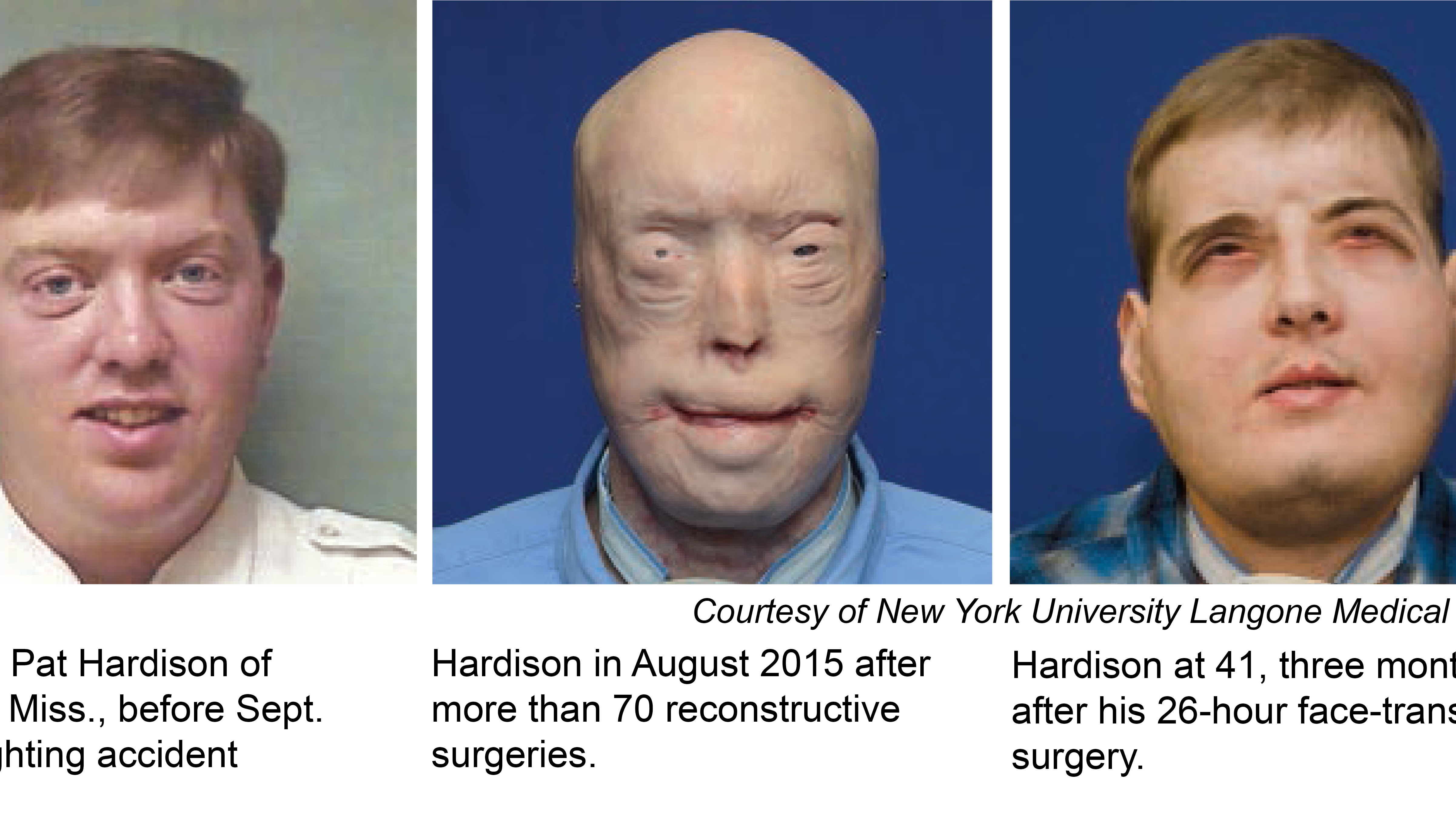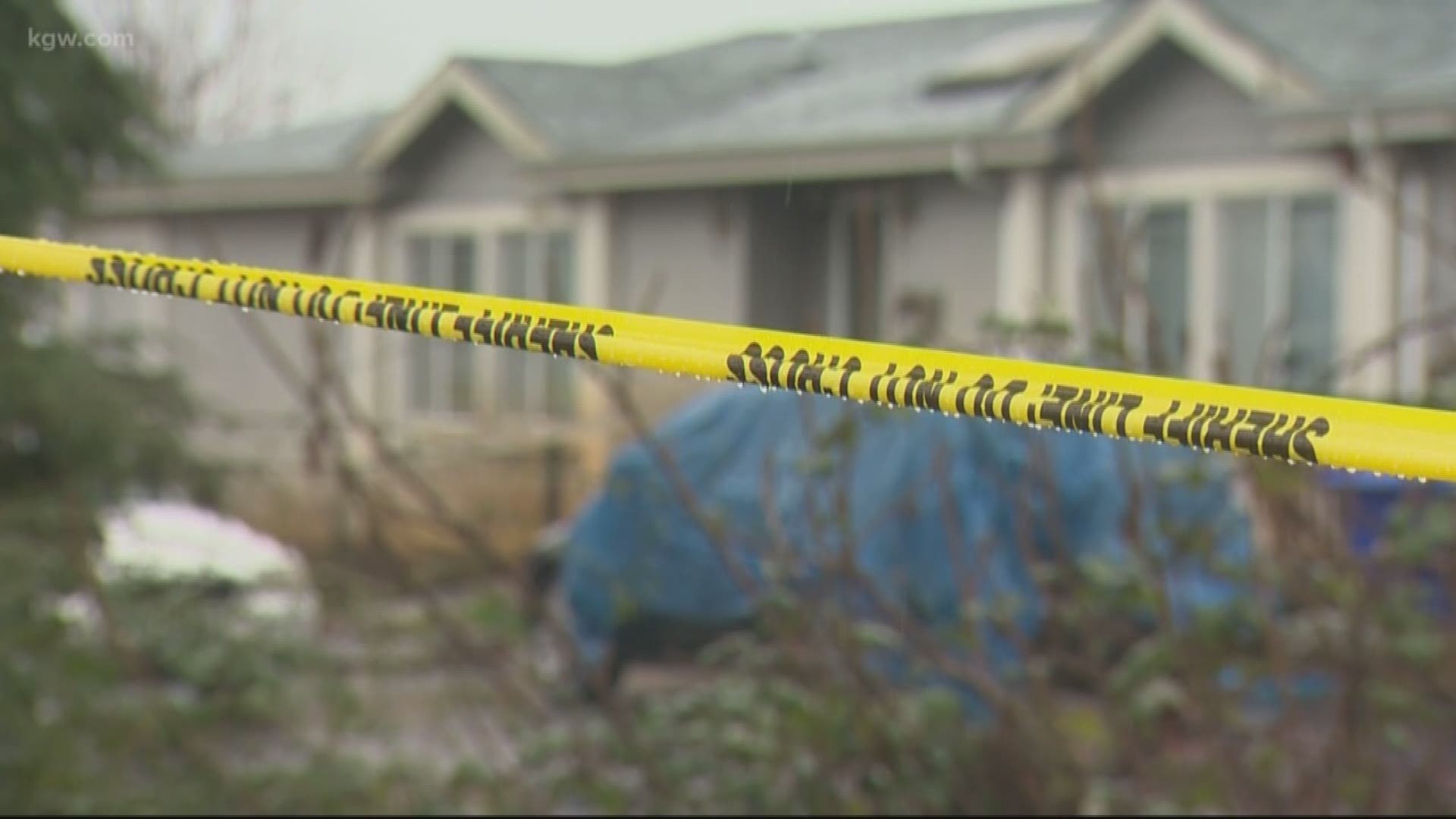SENATOBIA, Miss. — Pat Hardison remembers most of the day in September 2001 when his face was so badly burned that his fellow firefighters didn't recognize him.
The fire started in a house in this city about 40 miles south of Memphis. Crews conducted an interior search and didn't think anyone was in there.
But the homeowner was convinced that his wife remained inside, said Hardison, who was 27 years old at the time.
He and his partner put on new airpacks and went back in. That's when the sky fell, not just for Hardison, but for his whole department.
"The ceiling came down, and I could see everything melting on me. So I just had to hold my breath and throw everything off so I could get to a window," Hardison said.
Hardison visited Senatobia's Fire Station No. 2 during a small get-together Saturday. Last August, the volunteer firefighter received an extensive face transplant covering his skull and much of his neck.
Fellow firefighter Bricky Cole, one of about 8,000 residents in Senatobia, has known Hardison most of his life.
"When I came out, my chief was yelling 'Help him, help him,' and all I knew was someone was hurt," Cole said. "We worked on him for what seemed like an hour, but it was probably only 20 minutes. I didn’t even know who he was until we put him in the ambulance."
That's when Hardison spoke to him.
"He’s been family to me ever since I was little, and I can remember him kneeling down over me and he said, 'I don’t know who this is,' and I grabbed him and said, 'Man it’s not that bad,'" Hardison said.
But it was that bad. Hardison's entire face had been burned extensively, including his head, neck and upper torso. He lost his ears, eyebrows, eyelids, hair follicles, lips and most of his nose.

Once a firefighter, always a firefighter
As a volunteer firefighter, Hardison was the one they could count on to make it to every call, fellow firefighters said.
Capt. Neal Copeland and Hardison were rookies together and were among Tate County's first certified firefighters.
"He was here, always wanted to be the first one at the station, the first one on the truck, off the truck," Copeland said. "He wanted to do the best and be the best, and I think that’s what drug him along here (in his recovery) is he had that desire not to quit."
Elaine Hardison, Pat's mother, said his decision to become a firefighter may have been made before he was born. Her brother, his wife, and their unborn child died in 1973 in a Holly Springs, Miss., house fire.
When Pat Hardison said he wanted to join the fire department, his mother was nervous. But he took to it like a fish to water.
When the emergency tones went off, he would leave his job at his father's Goodyear store even if he was in the middle of a sale. He always was the first to get to the station, said Chief Gary Copeland, Neal's father.
"I was really concerned, I wanted to say no, but in my heart I knew if I did and something happened, he’d always feel like I told him not to, like it was his fault and it wasn’t," she said.
Children screamed and cried
The years after Pat Hardison's injury, which damaged his entire face, were hard for him and everyone who loves him. He had been an outgoing practical joker but started stay inside.
People didn't understand how he had received his injuries and were cruel, sometimes inadvertently.
"Pat loved to go out and eat. It was his favorite thing to do," Elaine Hardison said. "But he would go out and people looked at him like he was a freak.
"They called him names, children screamed and cried, and parents said, 'If you don’t want people staring at you, don’t go out,' " his mom said. "He was a people person. He always loved to be around people, and it hurt him so bad."
Pat Hardison also stopped coming by the fire station, Gary Copeland said.
"He loved it so much that he said he just couldn’t come down and be around the fire department anymore. He said, 'I can’t help, and the best thing to do is stay away,' " the chief said.
Jimmie Neal, a firefighter in Tunica, Miss., said he and Pat Hardison had been friends since they were in eighth grade. Seeing his friend withdraw was hard to watch.
"It was there, but it was only there part of the time, and it wasn’t like the normal Pat that always cut up," he said. "It was there, but you had to pull it out of him.
Since the transplant, "Now it’s 100% there," Neal said.
The brotherhood of firefighters
Pat Hardison's injury changed the entire fire department, Gary Copeland said.
"You know, it was a big change. It was the only real serious injury we ever had, and there were some people who said, 'I’ve had all I want. I’m through with it,'" the chief said. "We had a lot of soul searching, but everything that was done that day was by the book. It was just one of those bad accidents."
Former Director Robert Latham of the Mississippi Emergency Management Agency had been the chief when Pat Hardison was recruited and had left for the state job about a year before the accident. He said he went over what happened again and again in his mind, wondering if he could have done anything differently.
"There are always times you wonder, 'Was there something I could have done as a chief to make sure he was better trained?' But this is a dangerous profession, and that day was just one of those days that things went south quick," Latham said.
And so for 15 years, Pat Hardison has lived with the consequences.
Cole said Pat Hardison's injury did not exist only that night in his mind. It has been with him since the night it happened.
"That boy, he was alive, but he was dead," Cole said. "He kept himself in the house, he stayed at home, he stayed away from us, and that’s understandable."
'He was her miracle baby'
In 2011, doctors told Pat Hardison he couldn't drive anymore. His eyesight was deteriorating in part because he had no eyelids, only holes in the scarred skin of his face that let in light to his pupils.
The loss of independence hit him hard, which led a friend to go online and research face transplants. That led Pat Hardison to New York's Eduardo Rodriguez, a plastic surgeon with a specialty in reconstructive surgery.
Since Isabelle Dinoire's first partial face transplant in 2005 in Amiens, France, about 40 others have occurred. But Pat Hardison's case was unique because of the need to save his eyesight and introduce functioning eyelids, Rodriguez said.
Pat Hardison said he was up to the challenge.
"It always takes a courageous individual because we could not provide any data about the success of this operation," Rodriguez said. "Nothing like this had ever been done."
After two false alarms on facial donors, Pat Hardison got a call. A Brooklyn bike courier named David Rodebaugh, 26, had been critically injured in a bike wreck, and he was a tissue match.
Rodriguez met with the family.
"When you’re asking a person at a very difficult time for their loved one’s face, it’s not an easy question. And there's never an easy answer, but what an amazing family," he said.
Elaine Hardison said she can't imagine what Rodebaugh's mother went through but she thanks God for the woman's decision every day. She considers both of their sons miracles.
"His mom had not been able to have children — they told her she’d never have a child — so she knew he was her miracle baby," she said.
Rodebaugh and Pat Hardison were a match in more ways than one.
"On the day that I met David’s mother, she spent a lot of time telling me about his story and his life, and the primary motivation for her to donate his face was that her son had always wanted to be a firefighter," Rodriguez said. "She thought of no greater gift than to help out Patrick Hardison, who had sustained this injury during a volunteer firefighter mission."
Pat Hardison doesn't take for granted that Rodebaugh will always be with him.
"We’re forever linked together for the rest of my life, and it’s remarkable the things we had in common and never knew each other," he said. "His mother gave up her only child. She never hesitated when asked about his organs, and she helped six people that day."
He said now he has a responsibility to Rodebaugh's family as well.
"I wouldn’t let David's family down by not taking care of this miracle and doing the things it takes to survive," he said.
'Please let me have some kind of miracle'
Almost a year after his Aug. 14-15 surgery, Pat Hardison has had no signs of rejecting the transplant, which is unheard of in such a surgery. He attributes that to following the doctors' directions.
"I remember praying, at night, asking God, 'Please let me have some kind of miracle where I can get as close to normal as possible.' And this is where we are today," he said.
"I asked God why daily, 'What is the purpose of this accident? Why did you take the one thing that I love other than my kids in this world away from me?' and this is his reveal to me: 'I did that so you can help those other people, those wounded warriors, those 22 veterans a day who commit suicide.' "
Rodriguez said that's part of his dream, too: "The ability to provide a functioning face with functioning eyelids to protect his vision so that he can drive, giving him independence.
"And it could not have gone to a more deserving individual, a first responder," Rodriguez said. "It brings a great deal of hope to our wounded warriors, wounded veterans and anyone from the civilian population who has experienced such an injury."
Now, Pat Hardison is excited about his new lease on life when asked what he'll do next.
"Whatever I want to do," he said. "Just healing and enjoying my family, writing a book, hoping that does well, and I guess we'll just wait and see."
Follow Therese Apel on Twitter: @TRex21

